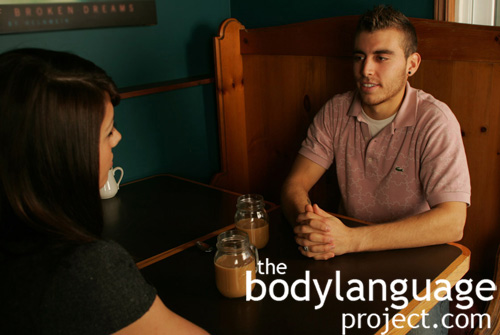Body Language of Leg Cleansing or Leg Pacifying Behaviour
 Cue: Leg Cleansing or Leg Pacifying Behaviour
Cue: Leg Cleansing or Leg Pacifying Behaviour
Synonym(s): Wiping The Hands On The Thigh, Rubbing the Thighs, Hand Rubbing Thigh, Thigh Stroke, Palm Cleansing.
Description: The hands are wiped or rubbed up and down against the thighs palm down.
In One Sentence: Rubbing the hands on the legs is a pacifying behaviour which is the result of nervousness.
How To Use it: Rubbing the hands on the lap can help sooth nerves as it stimulate the release of positive hormones. Use the gesture to remove perspiration from the hands, but do many sure it is done out the sight from viewers, as others will clue into your discomfort and stress and may capitalize on it. This is especially so in a business context.
Generally, however, due to its negative origins, the cue should be avoided unless absolutely necessary.
Context: General.
Verbal Translation: “I’m stressed, nervous or anxious and I’m wiping my hands on my thighs to sooth and calm my nerves by burning some calories and wipe the sweat from my hands.”
Variant: Hands can be rubbed against the chest or the sleeves of the arms.
Cue In Action: a) Just before shaking hands he wiped his hands on his thighs so his hands didn’t appear clammy. b) It was a big purchase and he was stressed. Below the table, he was rubbing his hands anxiously against his thighs over and over again.
Meaning and/or Motivation: In response to stress and sweating, the hands are rubbed against the thigh. It serves three purposes. One, it wipes sweat off the palms; two, it burns off nervous energy; and three, it pacifies. The friction between the hands helps to produce comforting feelings, a tactic soothing to help calm a person down. When someone is caught doing the leg cleanse, we know that they are nervous or anxious.
Cue Cluster: The hands might touch the back of the neck, pull at the skin under the throat or cover the neck dimple, massage the temples, the fingers might interlock to try to appear calm and collected, the eyes might wince or grimace, and the lips might purse or stretch across the face. A general uneasiness will accompany leg pacifying behaviour.
Body Language Category: Auto contact or self touching, Displacement behaviour, Energy Displacement, Stroking body language, Fearful body language, Low confidence body language, Nervous body language, Pacifying body language, Stressful body language.
Resources:
Abe, N., M. Suzuki, E. Mori, M. Itoh, and T. Fujii. 2007. Deceiving others: distinct neural responses of the prefrontal cortex and amygdale in simple fabrication and deception with social interactions. Journal of Cognitive Neuroscience 19: 287-295.
Akehurst, L., G. Kohnken, A. Vrij, and R. Bull. 1996. Lay persons’ and police officers’
beliefs regarding deceptive behaviour. Applied Cognitive Psychology 10: 461-471.
Appelbaum, P.S. The new lie detectors: Neuroscience, deception, and the courts. Psychiatric Services. 2007. 58: 460-462.
Allen, J.A., Armstrong, J.E. and Roddie, I.C. The regional distribution of emotional
sweating in man. J. Physiol. 235, 749–759 (1973).
Altman, R.S. and Schwartz, R.A. Emotionally induced hyperhidrosis. Cutis 69, 336–338
(2002).
Beidel, D. C., Turner, S. M., & Dancu, C. V. (1985). Physiological, cognitive and behavioral aspects of social anxiety. Behaviour Research and Therapy, 23, 109–117.
Barroso, Felix ; Feld, Jason. Self-touching and attentional processes: The role of task difficulty, selection stage, and sex differences. Journal of Nonverbal Behavior. 1986. 10(1): 51-64.
Butzen, Nathan David ; Bissonnette, Victor ; Mcbrayer, Dan. Effects of modeling and topic stimulus on self-referent touching. Perceptual and motor skills. 2005. 101(2): 413-20.
Broome, Marion E.. Helping Parents Support Their Child In Pain. Pediatric Nursing. 2000. 26(3): 315.
Bornstein, Marc H. ; Tamis-Lemonda, Catherine S. Maternal responsiveness and infant mental abilities: Specific predictive relations. Infant Behavior and Development. 1997. 20(3): 283-296.
Buckley, V., & Semple, S. (2012). Evidence that displacement activities facilitate behavioural transitions in ring-tailed lemurs. Behavioural Processes, 90, 433–435.
Bernal, Gilda Rios ; Wortham, Suec. How to Calm Children through Massage. Childhood Education. 1997. 74(1): 9-14.
Bouhuys, A.L. ; Jansen, C.J. ; van den Hoofdakker, R.H. Analysis of observed behaviors displayed by depressed patients during a clinical interview: relationships between behavioral factors and clinical concepts of activation. Journal of Affective Disorders. 1991. 21(2): 79-88.
Bouhuys, A.L. ; Beersma, Domien G.M. ; van den Hoofdakker, Rutger H. Observed behavior as a predictor of the response to sleep deprivation in depressed patients. Psychiatry Research. 1989. 28(1): 47-61.
Berridge CW,Mitton E, ClarkW, Roth RH. 1999. Engagement in a non-escape (displacement) behavior elicits a selective and lateralized suppression of frontal cortical dopaminergic utilization in stress. Synapse 32:187–197.
Bond, Michael H., and Hiroshi Komai (1976). “Targets of Gazing and Eye Contact During Interviews: Effects on Japanese Nonverbal Behavior.” In Journal of Personality and Social Psychology (Vol. 34), pp. 1276-84.
Blakeslee, Sandra (1995). “In Brain’s Early Growth, Timetable Maybe Crucial.” In New York Times (“Science Times,” August 29), pp. C1, C3.
Caplovitz Barrett, Karen. The origins of social emotions and self-regulation in toddlerhood: New evidence. Cognition & Emotion. 2005. 19(7): 953-979.
Castles, Duncan L. ; Whiten, Andrew ; Aureli, Filippo. Social anxiety, relationships and self-directed behaviour among wild female olive baboons. Animal Behaviour. 1999. 58(6): 1207-1215.
D’alessio, M. ; Zazzetta, A. Development of Self-Touching Behavior in Childhood. Perceptual and Motor Skills. 1986. 63(1): 243-253.
Chalmers, T.M. and Keele, C.A. The nervous and chemical control of sweating. Br. J. Dermatol. 64, 43–54 (1952).
Drummond, P. D., & Lance, J. W. (1987). Facial flushing and sweating mediated by
the sympathetic nervous system. Brain, 110(Pt. 3), 793–803.
Drummond, P. D. (1994). The effect of anger and pleasure on facial blood flow.
Australian Journal of Psychology, 46, 95–99.
Drummond, P. D., & Quah, S. H. (2001). The effect of expressing anger on cardiovascular reactivity and facial blood flow in Chinese and Caucasians. Psychophysiology, 38, 190–196.
Drummond, Peterd. ; Su, Daphne. The relationship between blushing propensity, social anxiety and facial blood flow during embarrassment. Cognition & Emotion. 2012. 26(3): 561-567.
Ekman, Paul, and Wallace V. Friesen (1969). “Nonverbal Leakage and Clues to Deception.” In Psychiatry (Vol. 32), pp. 88-106.
Early, Charles E. ; Kleinknecht, Ronald A. Maher, Brendan A. (editor). The Palmar Sweat Index as a function of repression–sensitization and fear of dentistry. Journal of Consulting and Clinical Psychology. 1978. 46(1): 184-185.
Elaad, E. 2003. Effects of feedback on the overestimated capacity to detect lies and the underestimated ability to tell lies. Applied Cognitive Psychology 17(3): 349-363.
Edelstein, R. S., T. L. Luten, P. Ekman, and G. S. Goodman. 2006. Detecting lies in children and adults. Law and Human Behavior 30(1): 1-10.
Ekman, Paul; Friesen, Wallace V. 1974. Detecting deception from the body or face
Journal of Personality and Social Psychology. 29(3): 288-298.
Gregson, Kim D ; Tu, Kelly M ; Erath, Stephen A. Sweating under pressure: skin conductance level reactivity moderates the association between peer victimization and externalizing behavior. Journal of child psychology and psychiatry, and allied disciplines. 2014 55(1): 22-30.
Gross, Katharina M ; Schote, Andrea B ; Schneider, Katja Kerstin ; Schulz, André. Elevated social stress levels and depressive symptoms in primary hyperhidrosis
Meyer, Jobst. PloS one. 2014 9(3): e92412.
Goldberg, Shelly ; Rosenthal, Robert. Self-touching behavior in the job interview: Antecedents and consequences. Journal of Nonverbal Behavior. 1986. 10(1): 65-80.
Goodall, Jane (1986). The Chimpanzees of Gombe: Patterns of Behavior (Cambridge: Belknap Press of Harvard University).
Givens, David B. (1976). An Ethological Approach to the Study of Human Nonverbal Communication (University of Washington Ph.D. dissertation in Anthropology, Ann Arbor: University Microfilms).
Grand, Stanley (1977). “On Hand Movements During Speech: Studies of the Role of Self-Stimulation in Communication Under Conditions of Psychopathology, Sensory Deficit, and Bilingualism.” In Norbert Freedman and Stanley Grand, eds., Communicative Structures and Psychic Structures: A Psycholanalytic Interpretation of Communication (New York: Plenum Press), pp. 199-221.
Hernandez-Reif, Maria ; Diego, Miguel ; Field, Tiffany. Preterm infants show reduced stress behaviors and activity after 5 days of massage therapy. Infant Behavior and Development. 2007. 30(4): 557-561.
Harrison, Lynda Law. The use of comforting touch and massage to reduce stress for preterm infants in the neonatal intensive care unit. Newborn and Infant Nursing Reviews. 2001. 1(4): 235-241.
Hennessy, Michael B ; T. Williams, Michael ; Miller, Deborah D ; Douglas, Chet W ; Voith, Victoria L. Influence of male and female petters on plasma cortisol and behaviour: can human interaction reduce the stress of dogs in a public animal shelter?
Applied Animal Behaviour Science. 1998. 61(1): 63-77.
Harrigan, Jinni A. Self-touching as an indicator of underlying affect and language processes. Social Science & Medicine. 1985. 20(11): 1161-1168.
Harrigan, Jinni A.; Karen S. Lucic; Denise Kay; Anne McLaney and Robert Rosenthal. Effect of Expresser Role and Type of Self-Touching on Observers’ Perceptions. Journal of Applied Social Psychology. 1991. 21(7): 585-609.
Heaven, Laura ; Mcbrayer, Dan ; Prince, Bob. Role of sex in externally motivated self-touching gestures. Perceptual and motor skills. 2002. 95(1): 289-94.
Heaven, L ; Mcbrayer, D. External motivators of self-touching behavior. Perceptual and motor skills. 2000. 90(1): 338-42.
Harrison, J. The behaviour of the palmar sweat glands in stress Journal of Psychosomatic Research. 1964. 8(3): 187-191.
Katza, Carmit; Irit Hershkowitz; Lindsay C. Malloya; Michael E. Lamba; Armita Atabakia and Sabine Spindlera. Non-Verbal Behavior of Children Who Disclose or do not Disclose Child Abuse in Investigative Interviews. Child Abuse & Neglect. 2012. 36: 12-20.
http://bodylanguageproject.com/articles/reading-nonverbal-behaviour-child-abuse-cases-encourage-children-divulge-information-truth-telling
Krogstad, A. L. ; Mork, C. ; Piechnik, S. K. Daily pattern of sweating and response to stress and exercise in patients with palmar hyperhidrosis. British Journal of Dermatology. 2006. 154(6): 1118-1122.
Köhler, Thomas ; Troester, Ulrich. Changes in the palmar sweat index during mental arithmetic. Biological Psychology. 1991. 32(2): 143-154.
Köhler, Thomas ; Schuschel, Irena. Changes in the number of active sweat glands (palmar sweat index, PSI) during a distressing film. Biological Psychology. 1994. 37(2):.133-145.
Kirschbaum C, Pirke K-M, Hellhammer DH. 1993. The ‘Trier Social Stress Test’: a tool for investigating psychobiological stress responses in a laboratory setting. Neuropsychobiology 28: 76–81.
Kochanska, G., Coy, K. C., & Murray, K. T. (2001). The development of self-regulation in the first four years of life. Child Development, 72, 1091–1111.
Kochanska, G., Murray, K. T., & Harlan, E. T. (2000). Effortful control in early childhood: Continuity and change, antecedents, and implications for social development. Developmental Psychology, 36, 220–232.
Kammers, Marjolein P.M. ; de Vignemont, Frédérique ; Haggard, Patrick. Cooling the Thermal Grill Illusion through Self-Touch. Current Biology. 2010. 20(20): 1819-182.
Kenner, Andrew N. (1993). “A Cross-Cultural Study of Body-Focused Hand Movement.” In Journal of Nonverbal Behavior (Vol. 17, No. 4, Winter), pp. 263-79.
Lehman, E.B., Holtz, B.A., & Aikey, K.L. (1995). Temperament and self-soothing behaviour in children: Object attachment, thumbsucking, and pacifier use. Early Education and Development, 6(1), 53–72.
MacKinnon, P.C.B. Hormonal control of the reaction of the palmar sweat index to emotional stress. Journal of Psychosomatic Research. 1964. 8(3): 193-195.
Machado-Moreira, C.A. and Taylor, N.A. Psychological sweating from glabrous and
nonglabrous skin surfaces under thermoneutral conditions. Psychophysiology 49, 369–374 (2012).
Machado-Moreira, C.A. and Taylor, N.A. Sudomotor responses from glabrous and non-glabrous skin during cognitive and painful stimulations following passive heating. Acta Physiol. (Oxf) 204, 571–581 (2012).
Moszkowski, Robin J. ; Stack, Dale M. ; Chiarella, Sabrina S. Infant touch with gaze and affective behaviors during mother–infant still-face interactions: Co-occurrence and functions of touch. Infant Behavior and Development. 2009. 32(4): 392-403.
Maestripieri D, Schino G, Aureli F, Troisi A. 1992. A modest proposal: displacement activities as an indicator of emotions in primates. Anim Behav 44:967–979.
Mohiyeddini, C., Bauer, S., & Semple, S. (2013a). Displacement behaviour is associated with reduced stress levels among men but not women. PLoS One, 8, e56355.
Mohiyeddini, C., Bauer, S., & Semple, S. (2013b). Public self-consciousness moderates the link between displacement behaviour and experience of stress in women. Stress, 16, 384–392.
Mohiyeddini, C., & Semple, S. (2013). Displacement behaviour regulates the experience of stress in men. Stress, 16, 163–171.
Morris, Desmond (1994). Bodytalk: The Meaning of Human Gestures (New York: Crown Publishers).
McGrew, W. C. (1972). “Aspects of Social Development in Nursery School Children with Emphasis on Introduction to the Group.” In N. G. Blurton Jones, ed., Ethological Studies of Child Behaviour (Cambridge: University Press), pp. 129-56.
Ogawa T (1975) Thermal influence on palmar sweating and mental influence on generalized sweating in man. Jpn. J. Physiol. 25(4): 525–536.
Pecora, Giulia ; Addessi, Elsa ; Schino, Gabriele ; Bellagamba, Francesca. Do displacement activities help preschool children to inhibit a forbidden action? Journal of Experimental Child Psychology. 2014. 126: 80-90.
Pugh, George E. (1977). The Biological Origin of Human Values (New York: Basic Books).
Rosenfeld, Howard (1973). “Nonverbal Reciprocation of Approval: An Experimental Analysis.” In Argyle *, pp. 163-72.
Ruchinskas RA, Narayan RK, Meagher RJ, Furukawa S (2002) The relationship of psychopathology and hyperhidrosis. Br. J. Dermatol. 147(4): 733–735.
Park, H. S., T. R. Levine, S. A. McCornack, K. Morrison, and M. Ferrara. 2002. How people really detect lies. Communication Monographs. 69: 144-157.
Ruchinskas R (2007) Hyperhidrosis and anxiety: chicken or egg? Dermatology (Basel) 214(3): 195–196.
Schmidt-rose, T. ; Lehmbeck, F. ; Bürger, A. ; Windisch, B. ; Keyhani, R. ; Max, H. Efficient sweat reduction of three different antiperspirant application forms during stress-induced sweating. International Journal of Cosmetic Science. 2013 35(6): 622-631.
Sato, K. The physiology, pharmacology and biochemistry of the eccrine sweat gland. Rev. Physiol. Biochem. Pharmacol. 79, 51–131 (1977).
Stromwell, L. A., P. A. Granhag, and S. Landstrom. 2007. Children’s prepared and unprepared lies: can adults see through their strategies? Applied Cognitive Psychology 21 (4): 457-471.
Sporer, S. L. and B. Schwandt. 2007. Moderators of nonverbal indicators of deception: A meta-analytic synthesis. Psychology, Public Policy, and Law 13: 1-34.
Sitton, Sarah C; Griffin, Susan T. 1981. Detection of deception from clients’ eye contact patterns. Journal of Counseling Psychology. 28(3): 269-271.
Sturman, Edward D. Invluntary Subordination and Its Relation to Personality, Mood,
and Submissive Behavior. Psychological Assessment. 2011. 23(1): 262-276 DOI: 10.1037/a0021499
http://bodylanguageproject.com/articles/nonverbal-submission-men-women-depression-critical-examination-use-disuse-submission/
Smidfelt, K. ; Drott, C.. Late results of endoscopic thoracic sympathectomy for hyperhidrosis and facial blushing. British Journal of Surgery. 2011. 98(12): 1719-1724
Schino G, Perretta G, Taglioni AM, Monaco V, Troisi A. 1996. Primate displacement activities as an ethopharmacological model of anxiety. Anxiety 2:186–191.
Supplee, Lauren H ; Skuban, Emily Moye ; Shaw, Daniel S ; Prout, Joanna. Emotion regulation strategies and later externalizing behavior among European American and African American children. Development and Psychopathology. 2009. 21(2): 393-415.
Sommer, Robert (1969). Personal Space: The Behavioral Basis of Design (Englewood Cliffs, New Jersey: Prentice-Hall).
Tamres L, Janicki D, Helgeson VS (2002) Sex differences in coping behaviour: a meta-analytic review. Personal Soc Psychol Rev 6: 2–30.
Troisi A. 1999. Ethological research in clinical psychiatry: the study of nonverbal behaviour during interviews. Neurosci Biobehav Rev 23:905–913.
Troisi A. 2002. Displacement activities as a behavioral measure of stress in nonhuman primates and human subjects. Stress 5: 47–54.
Navarro, Joe. A four-domain model for detecting deception: an alternative paradigm for interviewing. The FBI Law Enforcement Bulletin. 2003. 72(6): 19(6).
von Hippel W, von Hippel C, Conway L, Preacher KJ, Schooler JW, et al. (2005) Coping with stereotype threat: denial as an impression management strategy. J Personal Soc Psychol 89: 22–35.
Van Der Zee, Sophie; Ronald Poppe; Paul J. Taylor; and Ross Anderson. To Freeze or Not to Freeze A Motion-Capture Approach to Detecting Deceit.
http://bodylanguageproject.com/articles/detect-lies-whole-body-nonverbals-new-lie-detector-successful-using-body-language-70/
Vrij, A., S. Mann, and S. Kristen. 2007. Cues to deception and ability to detect lies as a function of police interview styles. Law and Human Behavior 31 (5): 499-518.
Wilke K, Martin A, Terstegen L, Biel SS (2007) A short history of sweat gland biology. Int J Cosmet Sci 29(3): 169–179.
Wilson, Thad E. Sweating the details: what really drives eccrine output during exercise-heat stress.(Report). Journal of Physiology. 2013. 591: 2777(1)
How To Beat Airport Security With Body Language Thanks To Leaked CIA WikiLeaks:
http://bodylanguageproject.com/articles/how-to-beat-airport-security-with-body-language/
Surviving Secondary: https://wikileaks.org/cia-travel/secondary-screening/WikiLeaks_CIA_Assessment_on_Surviving_Secondary_Screening.pdf
Infiltrating Schengen: https://wikileaks.org/cia-travel/infiltrating-schengen/WikiLeaks_CIA_Advice_for_Operatives_Infiltrating_Schengen.pdf









